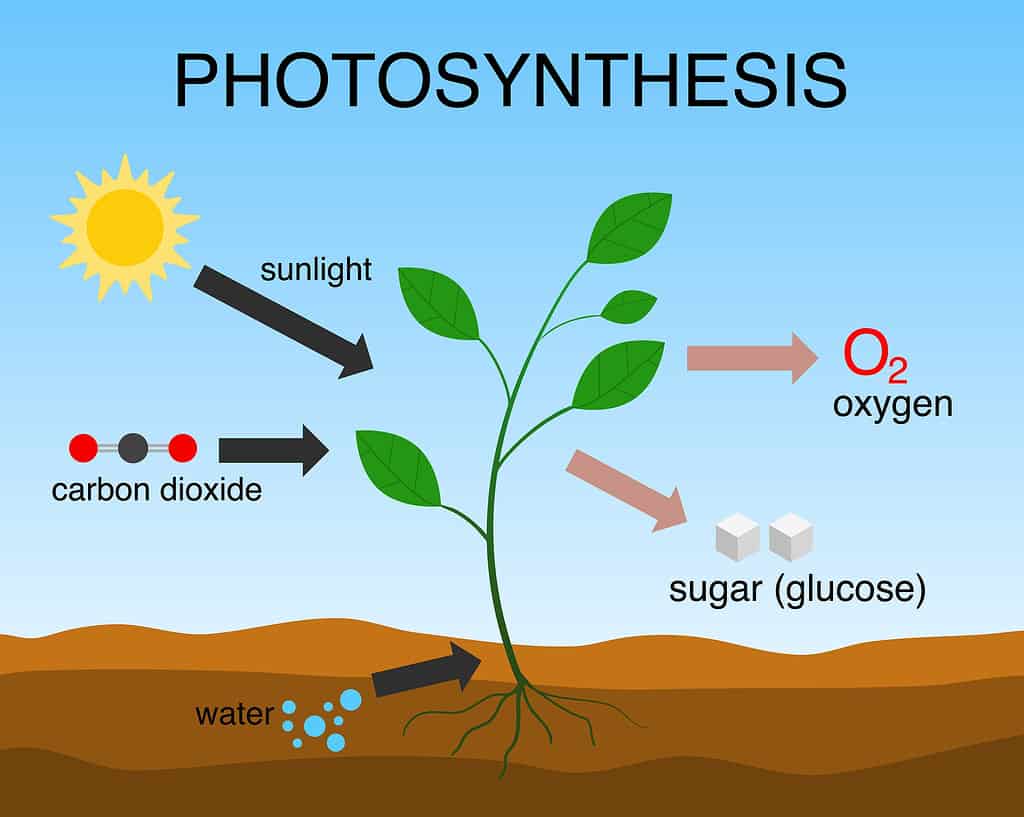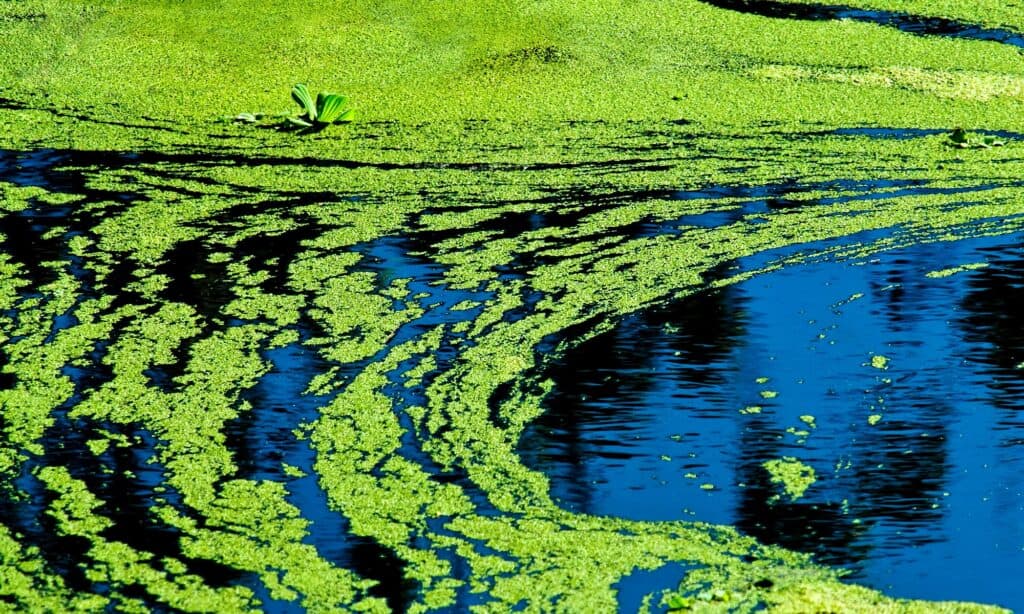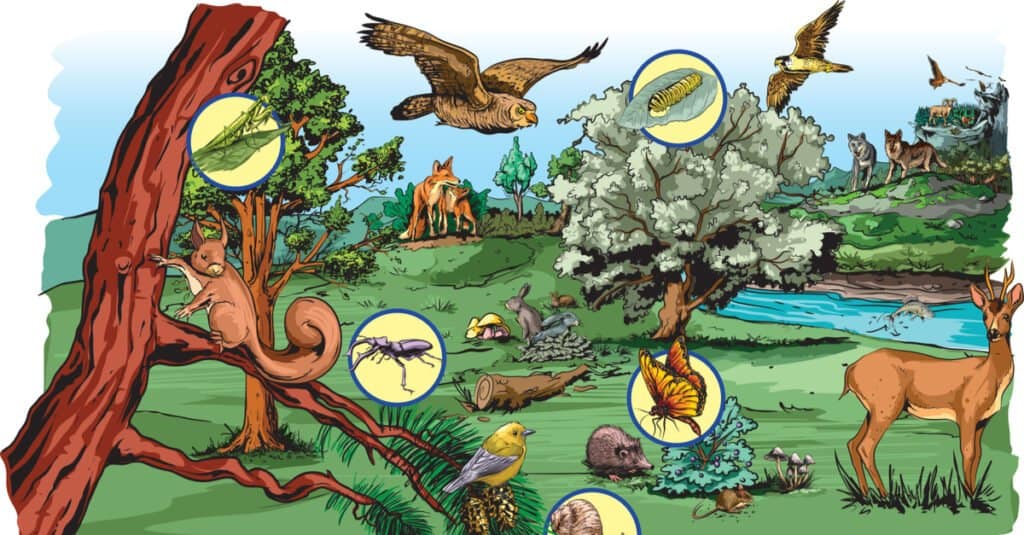A primary producer is an organism with the ability to create its food.
About Primary Producers
Primary producers are organisms that create organic compounds to feed themselves from inorganic carbon via photosynthesis or chemosynthesis. These organisms are also known as autotrophs, and they form the base of the food chain.
Primary producers form the base trophic level. In some way, all other creatures that cannot produce their own food rely on the biomass created by autotrophs to feed. Either the creatures directly feed on the organisms, like herbivores, or they feed on the herbivores, like carnivores.
How Do Primary Producers Create Food?
Autotrophs generate food in one of two ways: photosynthesis or chemosynthesis. Both methods help animals create organic compounds by using inorganic carbon, water, sunlight, or other chemical compounds.
Photosynthesis is a process that typically occurs in plants, but it can also occur in some sorts of bacteria. Organisms that engage in photosynthesis utilize sunlight to turn water and carbon dioxide into glucose.
Meanwhile, bacteria and some other organisms utilize chemosynthesis to create food by way of chemical reactions from inorganic chemicals. Chemosynthesis is not as well understood as photosynthesis. Organisms that engage in this form of food production live in extreme environments such as deep in the ocean where no sunlight can penetrate.
Therefore, the vast majority of known autotrophs are organisms that conduct photosynthesis. Photosynthetic organisms represent the primary level of food production in the world, and they are the first level in the food chain.

Producers mostly use photosynthesis to create food.
©aiyoshi597/Shutterstock.com
What Are 5 Examples of Primary Producers?
Several types of autotrophs exist, and they’re found just about anywhere that sunlight reaches and the temperatures are favorable.
Here are five examples of producers in the food chain:
1. Pine Trees
2. Grass
3. Algae
4. Moss
5. Bacteria
Each of these organisms uses sunlight to generate its food through photosynthesis, and they can be found throughout many parts of the Earth. Interestingly, some bacteria can be photosynthetic while others can engage in chemosynthesis. Autotrophs are very diverse and serve a vital role in the food chain in their environment.

Algae is a primary producer in the marine environment.
©iStock.com/Alexlky
How Do Primary Producers Fit into the Food Chain?
Autotrophs require water, sunlight, and inorganic carbon to make their food. As such, they are producers in a world that is full of consumers. Primary producers, like grass, are found at the very bottom of the food chain because they do not consume other creatures.
That’s why they are the base of the food chain as well as a very important part of a larger food web. Unlike consumers, though, they can only occupy one part of the food chain except when considering that the origin of some plant’s nutrients could come from deceased creatures.
Meanwhile, a single consumer can act as a primary, secondary, or tertiary consumer depending on their circumstances.

The interconnectivity of life means that every member of the food chain depends on the organisms that their food feeds upon.
©EreborMountain/Shutterstock.com
What Is an Example of a Food Chain with Primary Producers?
A food chain is generally made up of five portions. They are as follows:
1. Primary Producers
Primary producers are autotrophic organisms that utilize inorganic carbon and sunlight to produce food, like grass.
2. Primary Consumer
Primary consumers are animals that directly consume autotrophic animals. For example, an insect could feed on the grass in its environment, gaining nutrition. Typically, primary consumers are herbivores or at the very least omnivores.
3. Secondary Consumer
Secondary consumers are animals that eat primary consumers. A frog could feast on the insect that fed on the grass.
4. Tertiary Consumer
Tertiary consumers are animals that sit at the top of the food chain. They are apex predators that feast on the other animals in the food chain. For example, a bald eagle could eat the frog that ate the insect that ate the grass.
5. Decomposers
Decomposers are a part of the food chain. However, they function outside of the four stages that we’ve mentioned. Decomposers include bacteria, fungi, and other organisms. They each break down organic material, allowing the nutrients to be used elsewhere.
The easiest way to imagine this food chain working is that every level feeds the next level. Primary producers are consumed by primary consumers. Primary consumers feed secondary consumers. Secondary consumers are eaten by tertiary consumers. Decomposers lie outside of the typical food chain, but they serve the important function of breaking down organic matter.
Interestingly, not all creatures are stuck in one part of the food chain. For example, a brown bear is an apex predator in its environment. While it can eat deer as a tertiary consumer, a brown bear could just as easily consume plants, salmon, or other creatures. Their diverse diet facilitates their survival when prey is scarce. However, primary producers do not feed on other organisms.

Autotrophs are the base of the food chain.
©VectorMine/Shutterstock.com
The Importance of Primary Producers
Based on the food chain model, it’s clear that every insect, bird, and mammal depends on autotrophs in some way. A brown bear may not consume algae, but they eat salmon consume algae. Every other level of the food chain is dependent upon producers for food.
For that reason, it is crucial to protect plant diversity on land and in marine environments. If a large enough disruption occurs in an area’s population of primary producers, the consequences could be significant for every creature that depends on that food source to survive. That includes animals at the top of the food chain, like humans.








